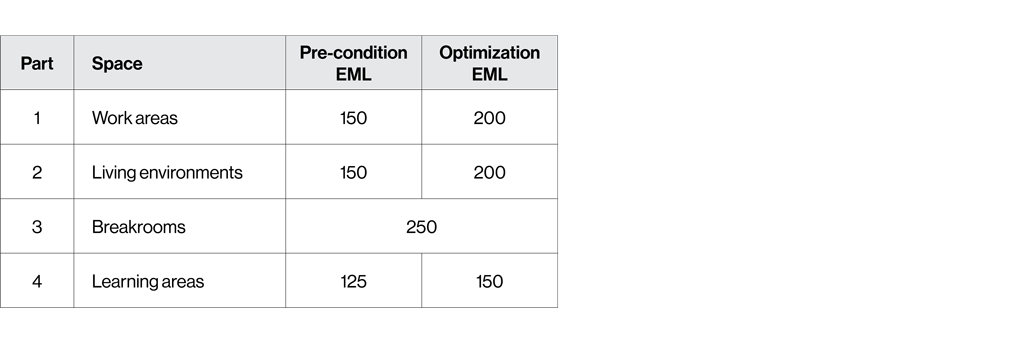WELL v1
Buildings and communities that help people thrive.
WELL v1
Buildings and communities that help people thrive.
The impact of interior lighting on human wellness, is one of seven key components that make up WELL Standard V1: LIGHT. Research indicates that lighting can also impact other areas of the WELL Standard, COMFORT and MIND, in particular.

LIGHT is comprised of eleven distinct features, all related to lighting within the built environment. It explores how lighting contributes to human behaviour, performance and overall wellbeing. These are:
| Feature | Key Variable | |
| 53 | Visual lighting design (pre-condition) | Illuminance and brightness design |
| 54 | Circadian lighting design (pre-condition) | Luminaires with spectrum optimized for EML |
| 55 | Electric light glare control (pre-condition) | Luminaires with good glare control |
| 56 | Solar glare control (pre-condition) | Shading and glazing design |
| 57 | Low glare workstation design (optimization) | Computer orientation and luminaire aiming |
| 58 | Color (optimization) | Quality Luminaire color quality |
| 59 | Surface design (optimization) | Surface material light reflectance |
| 60 | Automated shading and dimming controls (optimization) | Occupancy and daylight control |
| 61 | Right to light (optimization) | Interior design for window access |
| 62 | Daylight modeling (optimization) | Daylight design |
| 63 | Daylighting fenestration (optimization) | Fenestration design |
Lumenwerx can help designers and architects meet WELL standards v1 in the four features related to luminaire selection:
• Feature 54 – Circadian lighting design
• Feature 55 – Electric glare control
• Feature 58 – Colour quality
• Feature 60 – Shading and dimming
Achieving the WELL Standard for Circadian lighting design involves measuring Equivalent Melanopic Lux (EML), vertically at eye level. It is measured using the following formula:
EML=L x EML ratio
Note: EML measurements may include natural daylight.
Measuring vertical illumination
The best way to deliver vertical illumination at eye level is through either:
• Direct/indirect light distributions
Or
• Direct lighting with soft distribution
WELL requirements
The following guidelines show the EML minimums for WELL certification, in various aspects of the built environment.

Achieve the results you need with Luminaires that use:
• Bios LED
or
• Tunable white DUO
Recommended luminaires with bios LED
CLICK HERE
When designing for a modern, more human-centric built environment, lowering glare must be front and center. This can be achieved by choosing the right luminaires and configuring them for optimal comfort. The WELL standard for Electric Glare Control sets minimums for two requirements to help you effectively lower glare.
Part 1. Luminaire shielding
Part 2. Glare minimization
Satisfying these requirements depends on regulating luminaire luminance, or achieving a Unified Glare Rating (UGR) of less than 19.
Requirements: Luminaire shielding
The following chart outlines specific WELL allowances for various viewing angles and their shielding requirements:
Requirements: Glare minimization
Whether you’re lighting workstations, desks or seating areas in a regularly occupied space, feature 55 requires that:
• Luminaires more than 53° above the center of view (degrees above horizontal) must have a luminance of less than 8,000/m2
Or
• All areas must have a UGR of 19 or below
Recommended luminaires
CLICK HERE
The color and quality of light in a room can have a big impact on the comfort and motivation of those working in it. WELL feature 58 addresses color quality by setting minimum standards for electric lights in occupied spaces.
Requirements: Color quality
With the exception of decorative fixtures, emergency lights or other special-purpose lights, feature 58 requires that all electric lights must achieve:
• 90 CRI (or higher)
Or
• 80 CRI with a R9 of 50 (or higher)
Achieve the results you need with Luminaires that use:
• 90 CRI
Or
• Bios LED
Recommended luminaires
CLICK HERE
Personal control and Daylight strategies create healthier, happier environments for the people who live or work in them. WELL feature 60 provides guidelines for shading and dimming, along with responsive light control to ensure energy efficient spaces.
Requirements: Responsive Light Control
WELL encourages designers to use natural daylight when it’s available. When electric lighting is used (with the exception of decorative fixtures), feature 60 requires that all fixtures incorporate:
• Occupancy sensors to automatically dim luminaires by 20% when a room or zone is unoccupied
Or
• Daylight harvesting technology to automatically reduce electricity use when natural light is available
Recommended luminaires
All Lumenwerx luminaires will work with externally-mounted occupancy and daylight-harvesting sensors.